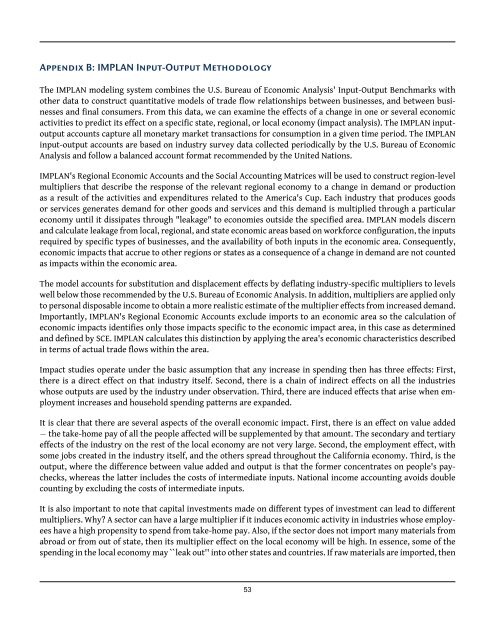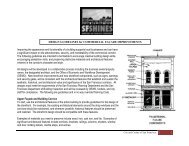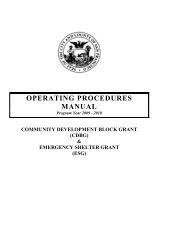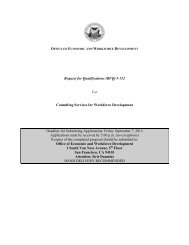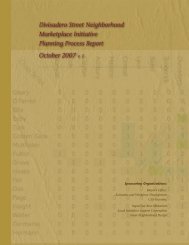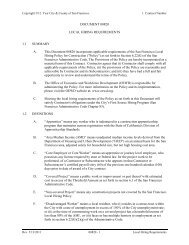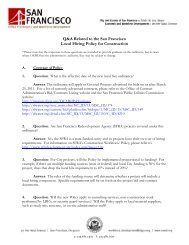The America's Cup: Economic Impacts of a Match - Bay Area Council
The America's Cup: Economic Impacts of a Match - Bay Area Council
The America's Cup: Economic Impacts of a Match - Bay Area Council
You also want an ePaper? Increase the reach of your titles
YUMPU automatically turns print PDFs into web optimized ePapers that Google loves.
Appendix B: IMPLAN Input-Output Methodology<br />
<strong>The</strong> IMPLAN modeling system combines the U.S. Bureau <strong>of</strong> <strong>Economic</strong> Analysis' Input-Output Benchmarks with<br />
other data to construct quantitative models <strong>of</strong> trade flow relationships between businesses, and between businesses<br />
and final consumers. From this data, we can examine the effects <strong>of</strong> a change in one or several economic<br />
activities to predict its effect on a specific state, regional, or local economy (impact analysis). <strong>The</strong> IMPLAN inputoutput<br />
accounts capture all monetary market transactions for consumption in a given time period. <strong>The</strong> IMPLAN<br />
input-output accounts are based on industry survey data collected periodically by the U.S. Bureau <strong>of</strong> <strong>Economic</strong><br />
Analysis and follow a balanced account format recommended by the United Nations.<br />
IMPLAN's Regional <strong>Economic</strong> Accounts and the Social Accounting Matrices will be used to construct region-level<br />
multipliers that describe the response <strong>of</strong> the relevant regional economy to a change in demand or production<br />
as a result <strong>of</strong> the activities and expenditures related to the <strong>America's</strong> <strong>Cup</strong>. Each industry that produces goods<br />
or services generates demand for other goods and services and this demand is multiplied through a particular<br />
economy until it dissipates through "leakage" to economies outside the specified area. IMPLAN models discern<br />
and calculate leakage from local, regional, and state economic areas based on workforce configuration, the inputs<br />
required by specific types <strong>of</strong> businesses, and the availability <strong>of</strong> both inputs in the economic area. Consequently,<br />
economic impacts that accrue to other regions or states as a consequence <strong>of</strong> a change in demand are not counted<br />
as impacts within the economic area.<br />
<strong>The</strong> model accounts for substitution and displacement effects by deflating industry-specific multipliers to levels<br />
well below those recommended by the U.S. Bureau <strong>of</strong> <strong>Economic</strong> Analysis. In addition, multipliers are applied only<br />
to personal disposable income to obtain a more realistic estimate <strong>of</strong> the multiplier effects from increased demand.<br />
Importantly, IMPLAN's Regional <strong>Economic</strong> Accounts exclude imports to an economic area so the calculation <strong>of</strong><br />
economic impacts identifies only those impacts specific to the economic impact area, in this case as determined<br />
and defined by SCE. IMPLAN calculates this distinction by applying the area's economic characteristics described<br />
in terms <strong>of</strong> actual trade flows within the area.<br />
Impact studies operate under the basic assumption that any increase in spending then has three effects: First,<br />
there is a direct effect on that industry itself. Second, there is a chain <strong>of</strong> indirect effects on all the industries<br />
whose outputs are used by the industry under observation. Third, there are induced effects that arise when employment<br />
increases and household spending patterns are expanded.<br />
It is clear that there are several aspects <strong>of</strong> the overall economic impact. First, there is an effect on value added<br />
− the take-home pay <strong>of</strong> all the people affected will be supplemented by that amount. <strong>The</strong> secondary and tertiary<br />
effects <strong>of</strong> the industry on the rest <strong>of</strong> the local economy are not very large. Second, the employment effect, with<br />
some jobs created in the industry itself, and the others spread throughout the California economy. Third, is the<br />
output, where the difference between value added and output is that the former concentrates on people's paychecks,<br />
whereas the latter includes the costs <strong>of</strong> intermediate inputs. National income accounting avoids double<br />
counting by excluding the costs <strong>of</strong> intermediate inputs.<br />
It is also important to note that capital investments made on different types <strong>of</strong> investment can lead to different<br />
multipliers. Why? A sector can have a large multiplier if it induces economic activity in industries whose employees<br />
have a high propensity to spend from take-home pay. Also, if the sector does not import many materials from<br />
abroad or from out <strong>of</strong> state, then its multiplier effect on the local economy will be high. In essence, some <strong>of</strong> the<br />
spending in the local economy may ``leak out'' into other states and countries. If raw materials are imported, then<br />
53


